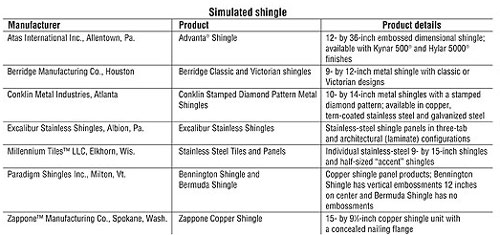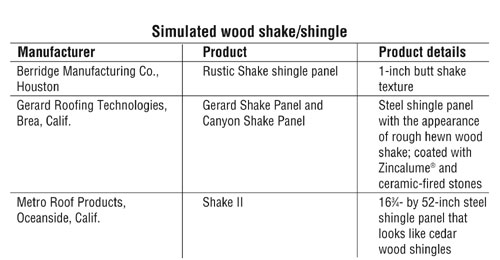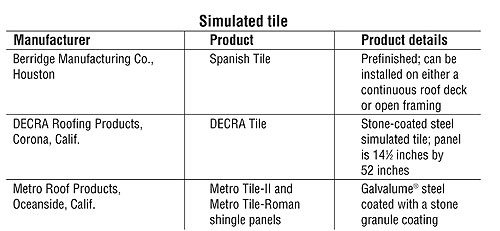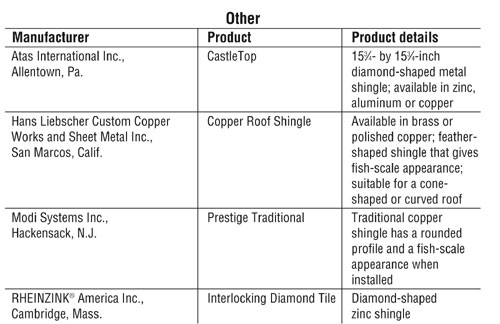Steep-slope metal roofing arguably is one of the fastest-growing segments of the roofing market, especially in the residential arena. Homeowners are looking to metal roof covering products for aesthetics and long-term service life.
As with all roof coverings, metal roof systems used for steep-slope applications must comply with applicable building codes. Many areas in the U.S. have adopted the International Building Code (IBC). Following are details regarding the installation, types and properties of metal shingles and shingle panels.
Definition
The 2006 edition of IBC divides metal roofing into two categories—metal roof panels and metal roof shingles. A metal roof panel is an interlocking metal sheet with a minimum installed weather exposure of 3 square feet; a metal roof shingle has weather exposure of less than 3 square feet.
NRCA further divides metal roof shingles into two groups—metal shingles and shingle panels. A metal shingle is formed to represent an individual asphalt shingle, tile, slate or wood shake/shingle configuration, and a shingle panel is designed to form a block of multiple shingles. Metal shingles and shingle panels also can be formed in various other shapes and a single course or multiple courses. Most of these metal roof shingles are press-formed during the manufacturing process to achieve individual shapes.
Because these products are intended for steep-slope applications, they are considered water-shedding roof systems designed to shed water rapidly over panel surfaces. They are not considered or intended to be watertight. To shed water rapidly, a roof must have a slope of 3-in-12 (14 degrees) or greater. For installations at lower slopes, enhanced underlayments are necessary and climatic conditions must be considered carefully, particularly the amount of expected ice, snow and debris accumulation.
Metal types and finishes
A wide variety of metals and metal alloys are available for fabrication of metal shingles and shingle panels. They can be divided into two main types: those that are naturally weathering, meaning their metallic surfaces possess or develop a layer of protection upon exposure to the elements, and those that require a factory-applied protective layer.
The most prevalent types of naturally weathering metals used for metal shingles or shingle panels are aluminum, copper, stainless steel and zinc.

Examples of some available simulated shingles
Metallic-coated carbon steel, such as Galvalume® and galvanized steel, also are used for metal shingles and shingle panels. These materials require a protective layer, such as a coating. Paint systems are the most common type of coating and generally are factory-applied. A majority of manufacturers use factory-applied paint systems that are baked-on fluoropolymers, high-quality coatings known by the registered trade names Kynar 500® and Hylar 5000.®
In addition, metal shingles and shingle panels may be coated with epoxy and ceramic granules or crushed stone chips to protect a roof and achieve aesthetic qualities.
Installation considerations
Metal shingle and shingle panel roof systems must be installed over continuous or closely spaced wood decks, wood-furring strips or metal or wood purlins using a batten or counterbatten system.
NRCA recommends an underlayment and slip sheet for metal shingle and shingle panel roof systems. An underlayment serves as a secondary barrier against water penetration. NRCA recommends a single layer of underlayment consisting of No. 30 asphalt-saturated, nonperforated felt or synthetic underlayment for roof slopes 4-in-12 (18 degrees) or greater. A double layer of underlayment is recommended for slopes of 3-in-12 to 4-in-12 (14 degrees to 18 degrees).
A slip sheet is a layer of smooth building paper, such as rosin-sized sheathing paper or unsaturated building paper. Its purpose is to protect the underlayment from the constant movement of metal shingles and shingle panels from expansion and contraction. A slip sheet also prevents metal from sticking to the primary underlayment.

A few examples of simulated shakes and shingles
In addition, an ice-dam protection membrane at downslope perimeters, transitions, valleys and around penetrations is recommended in cold regions and where required by local building codes.
Metal shingles and shingle panels generally are interlocked and overlapped and may be installed with clips or directly fastened to a substrate/roof deck. There are various methods of securement for metal shingles and metal panel roof systems. The appropriate type of fasteners for the substrate and fastener spacing are important for proper installation. Fasteners must be compatible with the base metal of a metal shingle or shingle panel to prevent galvanic corrosion. For example, only copper or stainless-steel fasteners should be used with copper shingles. Additionally, the service life of a fastener should be equal to or greater than the expected service life of the secured metal.
Wind clips or storm anchors also may be used to secure or fasten the butt or downslope edge of individual metal shingles or shingle panels in high-wind regions. Wind clips are made of steel or copper wire and sometimes are fabricated with an elongated shaft and disc base.
As with most steep-slope roof systems, metal shingle and shingle panel roof systems use sheet metal for perimeter flashings, valleys and associated flashings. Hip and ridge pieces generally are fabricated from the same material used for metal shingles and shingle panels. Manufacturers' specific requirements for sheet-metal flashing details vary depending on configuration and application requirements.
Characteristics
Fire, hail and wind resistance are building code-mandated requirements that must be considered when selecting a roof covering. Weight, maintenance and sustainability also are important considerations.
All metal shingles and shingle panels, regardless of metal type, are exempt from fire-resistance testing and by default receive an Underwriters Laboratories (UL) Inc. Class B fire-resistance rating. Ferrous and copper shingles and sheets receive a UL Class A rating without testing; other metal types need to be tested to receive a UL Class A fire-resistance rating. These fire-resistance ratings assume metal shingles and shingle panel roof coverings meet the minimum thickness requirements provided in IBC.
In areas where wildfires are a concern, building departments prohibit the use of wood roof coverings. Building owners who want the aesthetics of wood shakes or wood shingles can install metal shingle panels with those profiles. However, building owners should be aware the exterior fire classification might be lower in some re-cover situations.

These are some metal products that resemble slate.
Some metal shingle or shingle panel manufacturers have tested their products for hail resistance in accordance with UL 2218, "Standard for Impact Resistance of Prepared Roof Coverings." For this test, steel balls of varying sizes are dropped to simulate hailstones falling at peak velocity. Roofing materials then are classified as "Class 1" through "Class 4" with Class 4 representing the highest impact-resistant materials. The diameter of the steel ball increases with each classification level increase. An example of a Class 4 hail rating is Vail Titan Select by Custom-Bilt Metals, Chino, Calif.
For a roofing material to "pass" each classification level in UL 2218 means it has no visual evidence of tearing, fracturing, cracking, splitting, rupturing, crazing or other evidence of opening. Typically, metal will not crack on impact but will dent or deform. Although a Class 4 impact-resistant metal shingle or shingle panel roof covering may be able to shed water, it may be aesthetically unpleasing after impact.
Keep in mind softer metals like aluminum, copper and zinc are more susceptible to dents from large hail than equally thick steel-based metal roof products. Increasing impact resistance typically correlates to increased base metal thickness.
An additional impact test, FM 4473, "Test Protocol for Impact Resistance Testing of Rigid Roofing Materials by Impacting with Freezer Ice Balls," exists for steep-slope products. However, this test only is for rigid materials, such as slate and clay tile, and metal effectively is omitted from the scope.

Some examples of simulated tile
To provide wind-resistant ratings for metal shingle and shingle panel roof systems, a majority of metal shingle products have been tested per UL 1897, "Standard for Uplift Tests on Roof Covering Systems" or UL 997, "Standard for Wind Resistance of Prepared Roof Coverings." Several manufacturers offer transferable wind warranties. For example, DECRA Roofing Systems, Corona, Calif., tested its stone-coated steel shingle panel products for uplift resistance. Its Shingle, Shingle Plus, Shake and Tile shingle panels are marketed with a 120-mph wind warranty. Courtland, Ontario, Canada-based Dura-Loc Roofing System's Signature Series also has a 120-mph wind warranty. The Signature Series includes shake, tile and slate profiles.
An advantage of metal is its light weight. Generally, slate, concrete tiles and clay tiles can weigh 500 pounds per square to 1,900 pounds per square (100 square feet), and asphalt shingles can weigh about 200 pounds per square to 480 pounds per square. Metal roof systems commonly weigh 100 pounds per square to 200 pounds per square. A building owner with an existing structure that cannot support a heavy roof covering still can get the aesthetics of a clay/concrete tile or slate roof with a metal shingle or shingle panel system. Also, many metal roof systems are light enough to be installed over existing roof systems.
The amount of required maintenance for metal shingle and shingle panel roof systems is comparable to most other steep-slope roof systems. However, in areas where algae growth is a problem, metal roof coverings with smooth finishes may be viable alternatives to asphalt shingles and wood shakes/shingles.

Other metal products available for steep-slope roof systems
For building owners who want to use green building products, many metal roof coverings contain post-industry recycled content and are 100 percent recyclable. In addition, there are metal systems that can be installed directly over existing roof systems, eliminating (or at least deferring) the removal and disposal of construction materials in landfills.
Metal shingles and shingle panels can be finished with reflective coatings, which will reduce temperatures in roof assemblies and attics. In high solar load climates, such as in Phoenix or Miami, this can mean potential savings in cooling costs.
Metal shingle and shingle panel manufacturers now are providing products with reflectivity and emmissivity ratings that meet the U.S. Environmental Protection Agency and U.S. Department of Energy's ENERGY STAR® program requirements.
What's available
The accompanying charts provide a sampling of metal shingle and shingle panel products divided into five categories. NRCA gathered information from the NRCA 2005-06 Steep-slope Roofing Materials Guide, Metal Roofing Alliance and manufacturers' Web sites.
Please note inclusion or omission of a manufacturer's products or recommendations in this article does not imply endorsement by NRCA. In addition, NRCA does not possess or maintain any information about these products' performance records. The purpose of this article is to present available product types (with appropriate examples).
When researching this article, we discovered there is an abundance of manufacturers who offer a wide variety of steep-slope metal roof coverings. Roofing professionals and homeowners are encouraged to research and investigate metal shingle and shingle panel options for their specific roofing projects.
Joan P. Crowe, AIA, is an NRCA director of technical services and James R. Kirby, AIA, is an NRCA senior director of technical services.
